Mali Empire Worksheets
Do you want to save dozens of hours in time? Get your evenings and weekends back? Be able to teach about the Mali Empire to your students?
Our worksheet bundle includes a fact file and printable worksheets and student activities. Perfect for both the classroom and homeschooling!
Resource Examples
Click any of the example images below to view a larger version.
Fact File
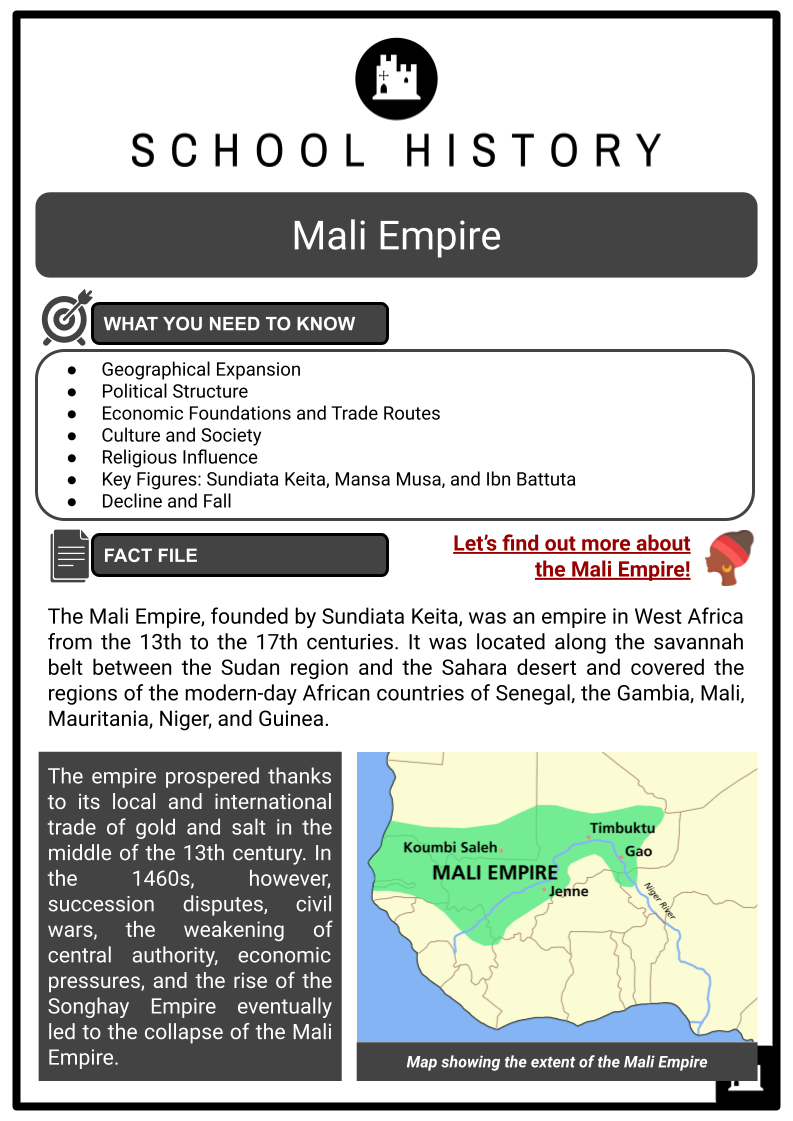
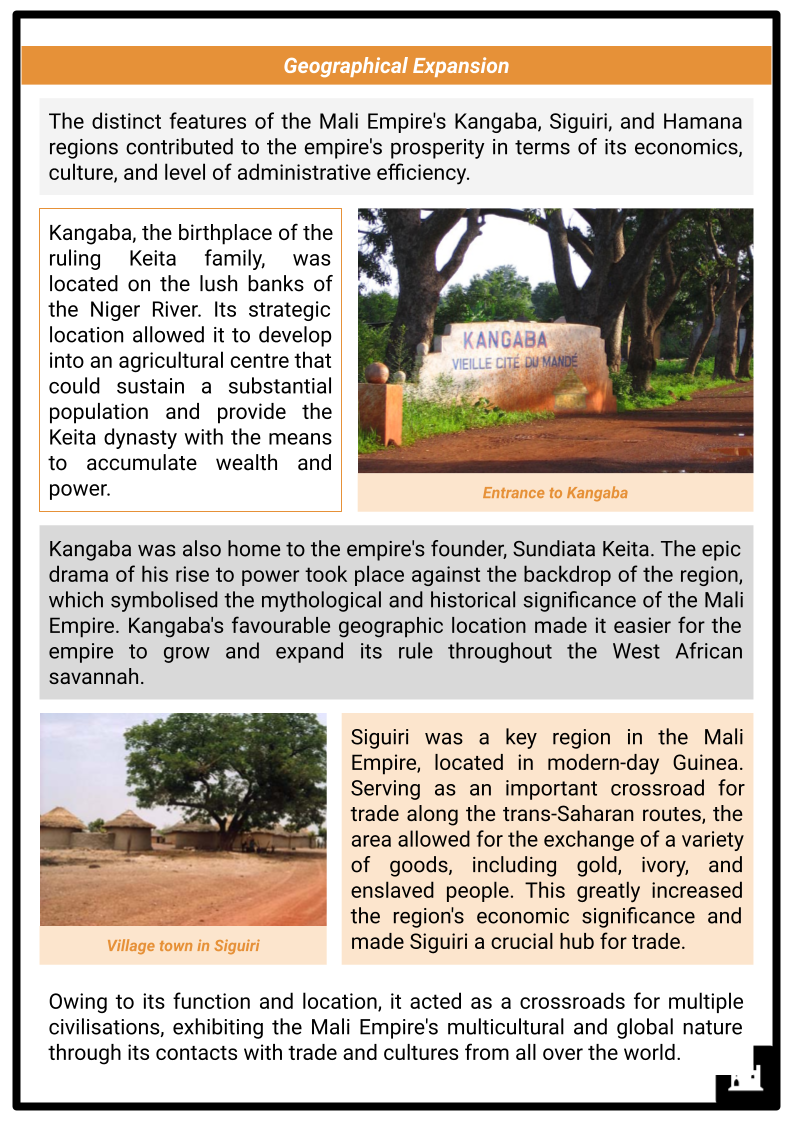
Student Activities
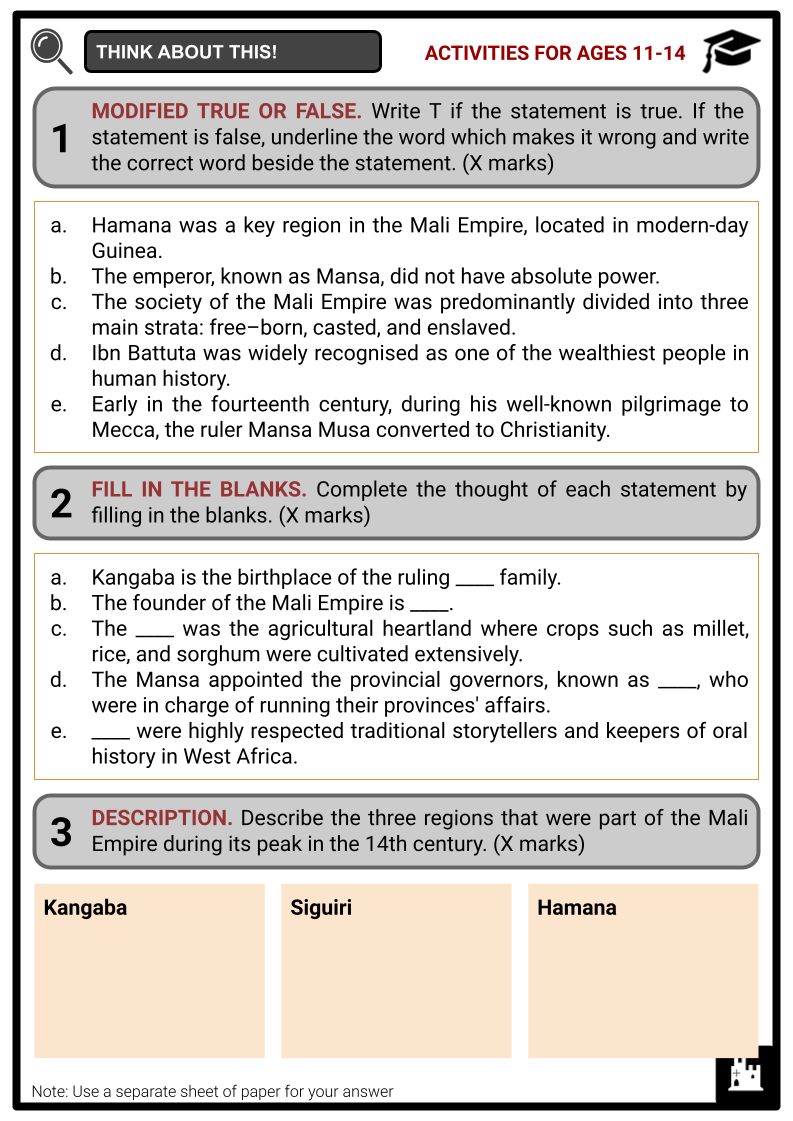
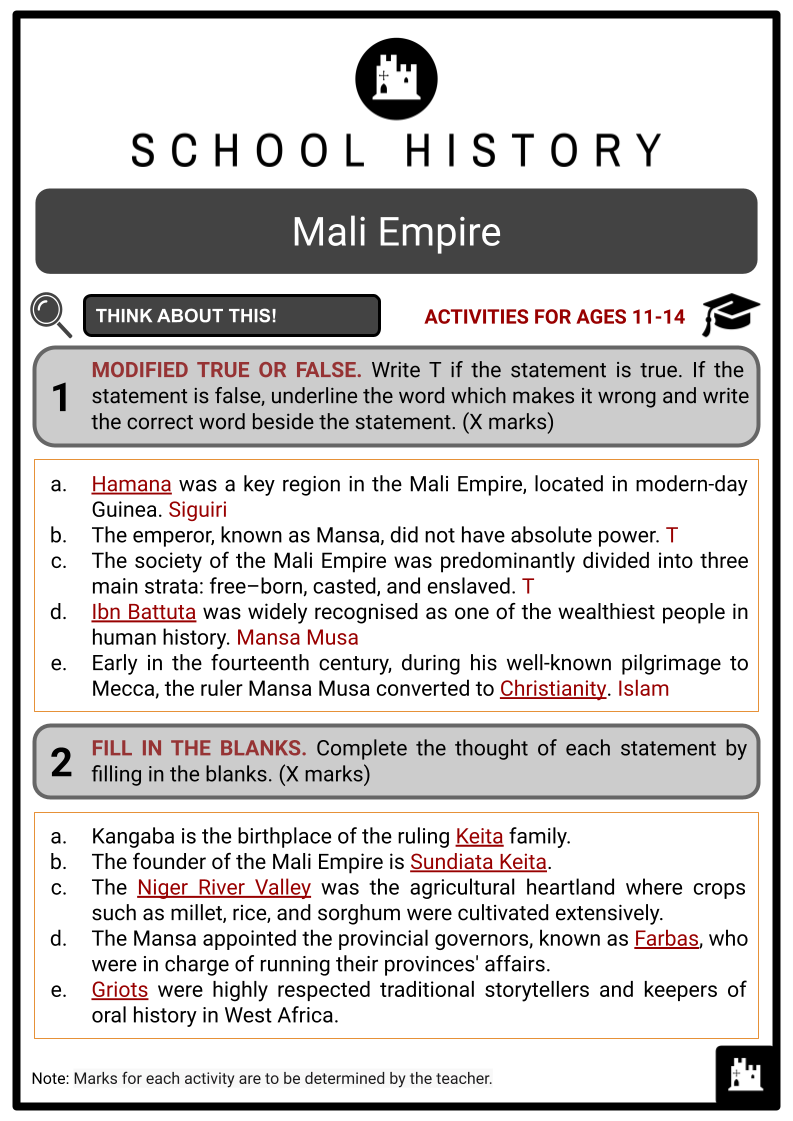
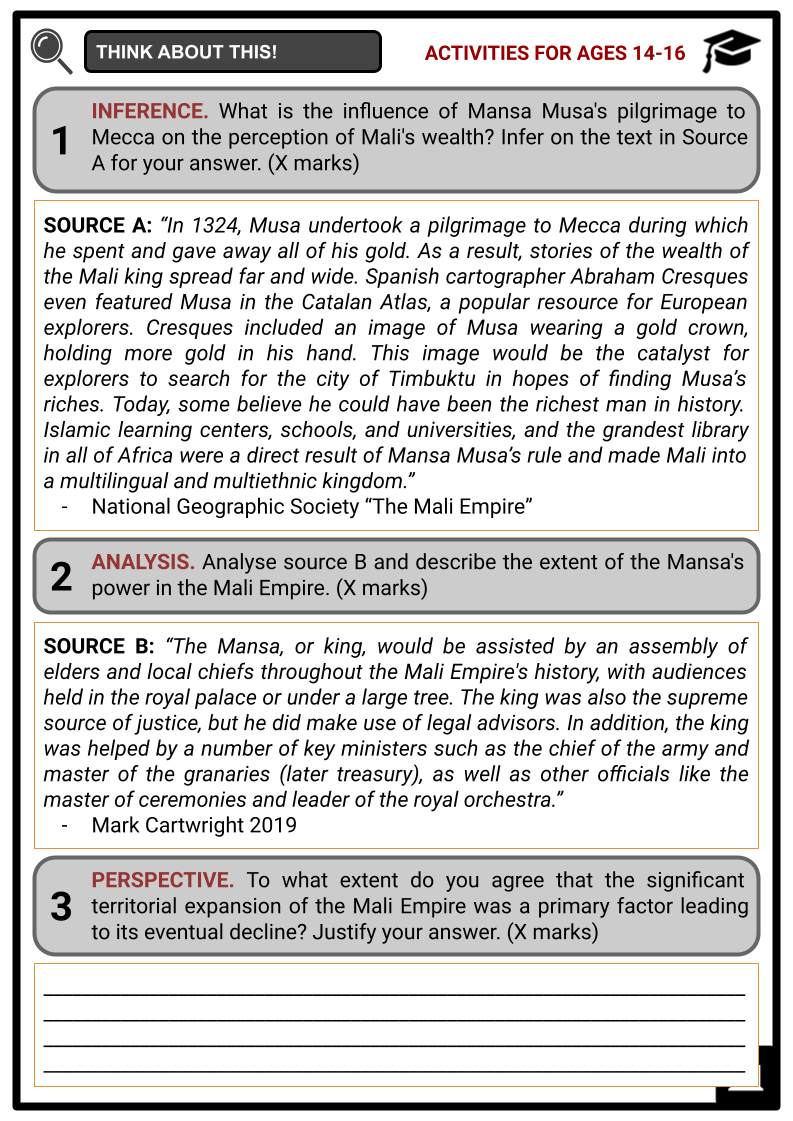
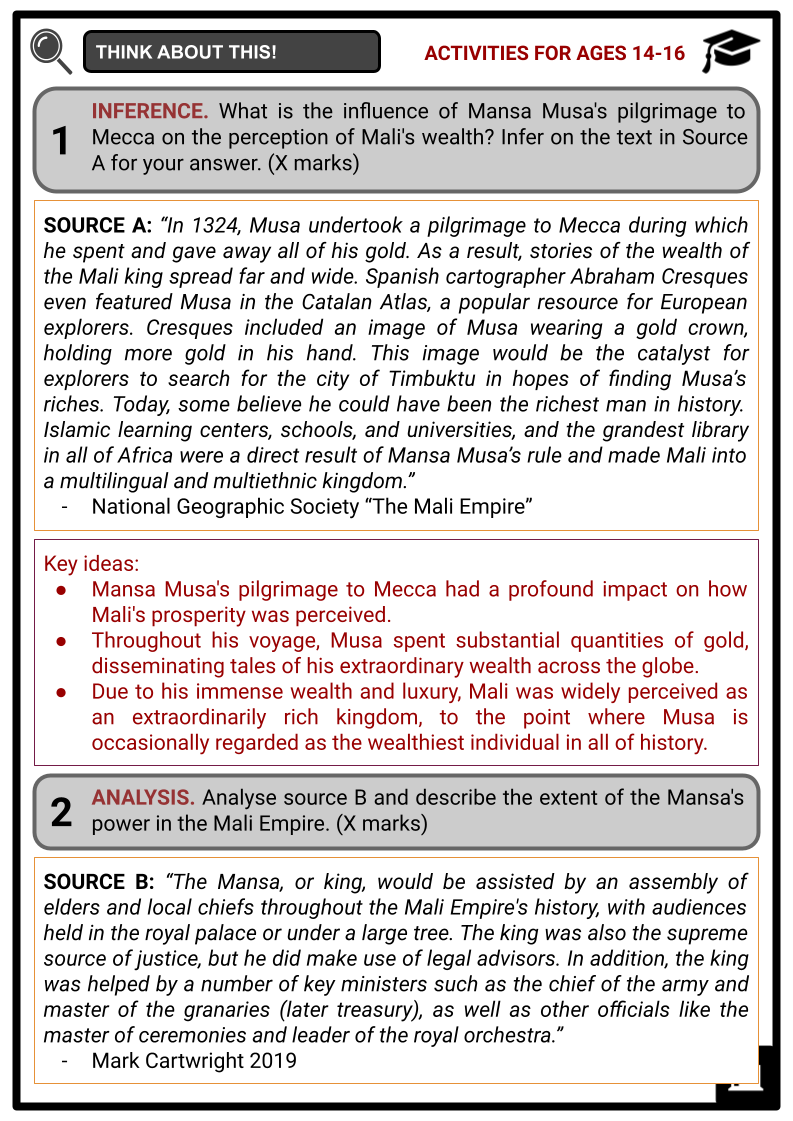
Summary
- Geographical Expansion
- Political Structure
- Economic Foundations and Trade Routes
- Culture and Society
- Religious Influence
- Key Figures: Sundiata Keita, Mansa Musa, and Ibn Battuta
- Decline and Fall
Key Facts And Information
Let’s find out more about the Mali Empire!
The Mali Empire, founded by Sundiata Keita, was an empire in West Africa from the 13th to the 17th centuries. It was located along the savannah belt between the Sudan region and the Sahara desert and covered the regions of the modern-day African countries of Senegal, the Gambia, Mali, Mauritania, Niger, and Guinea.
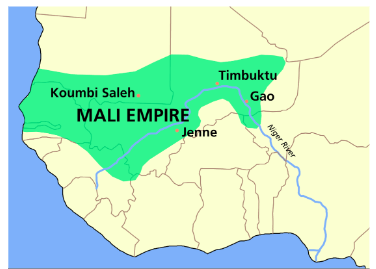
- The empire prospered thanks to its local and international trade of gold and salt in the middle of the 13th century. In the 1460s, however, succession disputes, civil wars, the weakening of central authority, economic pressures, and the rise of the Songhay Empire eventually led to the collapse of the Mali Empire.
Geographical Expansion
- The distinct features of the Mali Empire's Kangaba, Siguiri, and Hamana regions contributed to the empire's prosperity in terms of its economics, culture, and level of administrative efficiency.
- Kangaba, the birthplace of the ruling Keita family, was located on the lush banks of the Niger River. Its strategic location allowed it to develop into an agricultural centre that could sustain a substantial population and provide the Keita dynasty with the means to accumulate wealth and power.
- Kangaba was also home to the empire's founder, Sundiata Keita. The epic drama of his rise to power took place against the backdrop of the region, which symbolised the mythological and historical significance of the Mali Empire. Kangaba's favourable geographic location made it easier for the empire to grow and expand its rule throughout the West African savannah.
- Siguiri was a key region in the Mali Empire, located in modern-day Guinea. Serving as an important crossroad for trade along the trans-Saharan routes, the area allowed for the exchange of a variety of goods, including gold, ivory, and enslaved people. This greatly increased the region's economic significance and made Siguiri a crucial hub for trade.
- Owing to its function and location, it acted as a crossroads for multiple civilisations, exhibiting the Mali Empire's multicultural and global nature through its contacts with trade and cultures from all over the world.
- Finally, Hamana's iron mines gave it special significance. Because iron was so important to the Mali Empire's manufacturing of tools and weaponry, it was a highly valued resource. The wealth of Hamana's provisions significantly boosted the empire's economy.
- Apart from its economic role, Hamana was also a cultural centre that drew a number of griots, who were highly respected traditional storytellers and keepers of oral history in West Africa. The griots were vital in preserving the history of the empire, honouring its achievements, and preserving its traditions and culture.
- The regions of Kangaba, Siguiri, and Hamana had a significant impact on the Mali Empire's strength and reputation. The empire's geographic growth increased its riches and social makeup by allowing a wide range of commercial and cultural exchanges, in addition to extending its authority over more territory.
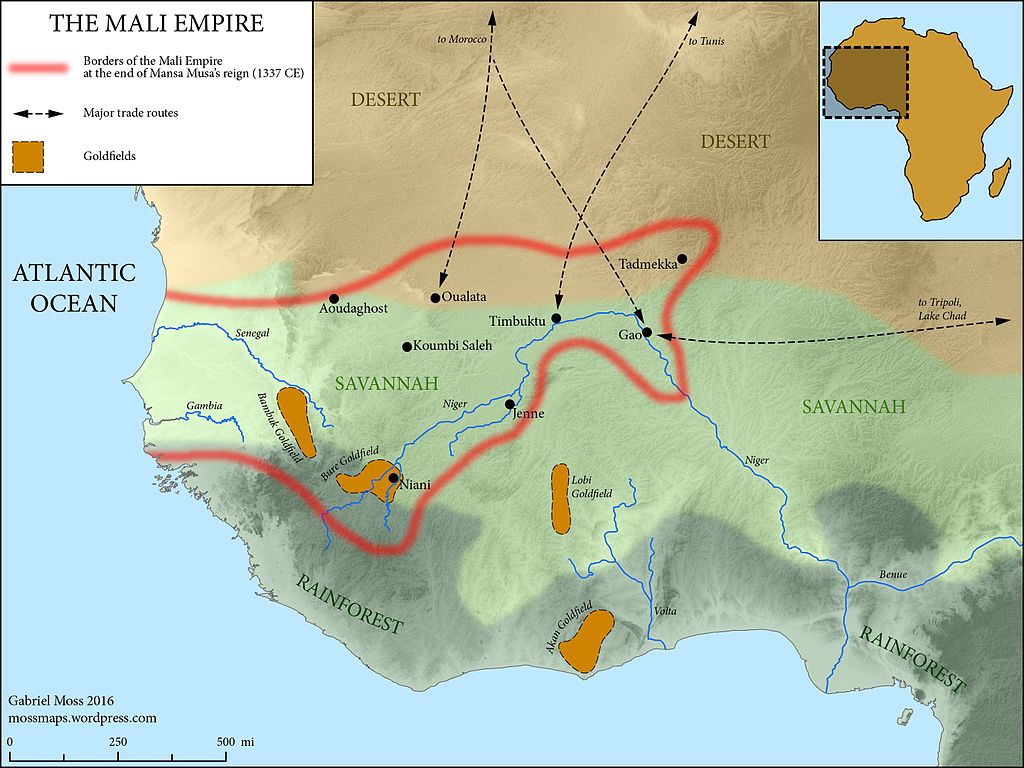
Political Structure
- The Mali Empire's organisation and power were greatly influenced by its political system. The Empire operated as a federation, with several sizable cities acting as regional centres of power.
- The emperor, known as Mansa, did not have absolute power, even though he managed foreign policy and domestic affairs. The council of elders, which was usually made up of people from the higher classes of society, was usually able to sanction the Mansa’s decisions. This council improved the administrative balance and efficiency of the Empire by acting as a sort of quasi-check on the Mansa.
- Underneath the central authority, a hierarchical structure existed within the provinces and districts.
- The Mansa appointed the provincial governors, known as Farbas, who were in charge of running their provinces' affairs, which included everything from keeping the peace to collecting taxes. Small councils of advisors were frequently present around them, further strengthening the system of checks and balances. In the local villages, the village chiefs, or headmen, held power. Respected members of their communities typically held these hereditary positions.
- The Mali Empire’s political structure was, thus, both centralised and localised–a delicate balance that allowed for efficient governance across its vast territories. The combination of local and imperial interests through this political structure ensured the empire’s stability and longevity, making it one of Africa's extraordinary pre-colonial states.
Economic Foundations and Trade Routes
- The economic foundations of the Mali Empire were based on agriculture, mining, and trade, with each contributing significantly to the empire's prosperity. The Niger River Valley, a fertile region, was the agricultural heartland where crops such as millet, rice, and sorghum were cultivated extensively. This agricultural productivity not only sustained the population but also created a surplus for trade.
- Mining became another crucial aspect of the economic framework of the Mali Empire. The empire gained notoriety for its abundant gold reserves, predominantly situated in the southern provinces, such as Bambuk and Bure. Furthermore, it exerted authority over the entrance to the trans-Saharan salt mines located in Taghaza.
- Trade was the third economic pillar, made possible by the empire's control over a vast network of trans-Saharan trade routes. They connected the Mali Empire to North Africa and the Mediterranean world. Merchants traversed these trade routes, exchanging valuable goods such as gold, salt, ivory, spices, and enslaved people.
- Timbuktu, in particular, gained significance as both a commercial hub and an intellectual centre. The riches acquired from trade were employed to construct educational institutions, mosques, and libraries, which enticed academics from diverse regions of the Islamic world. The region's renowned status was achieved through the combination of trade and education.
- The control of the Niger River also improved domestic commerce within the empire, enabling the transportation of products from the inland areas to the commercial centres located on the periphery. The river functioned as a commercial route, facilitating economic integration within the empire.
Culture and Society
- The vast territories under the Mali Empire’s control were reflected in the diversity of its culture and customs. The Mandinka, Fulani, and Soninke were just a few of the many ethnic groups that made up the Empire, and each one added something unique to the rich cultural tapestry.
- The empire promoted the growth of an intellectual culture by embracing Islam. This mingling of cultures was particularly noticeable in towns like Timbuktu and Djenne, where Islamic learning institutes were set up and attracted scholars from all over the Islamic world. Despite the acceptance of Islam, the majority of people kept up their observance of traditional African religions and practises, resulting in a distinctive blend of cultures.
- The abundance of oral literature and music was what made Mali's culture unique. Through their musical compositions and anecdotes, griots, often referred to as traditional storytellers, played a crucial role in preserving the history and customs of the empire. Keeping genealogical records, documenting history, and counselling the nobility were all part of their duties.
- Furthermore, visual arts like architecture and sculpture had a big impact on the empire's cultural expression. A prime example is the Great Mosque of Djenne, an outstanding example of Sudano-Sahelian architecture that stands as a testament to the empire's cultural heritage.
- Lineage and profession played a significant role in determining status. The society was predominantly divided into three main strata: the free-born, consisting of nobles, officials, warriors, and traders; the casted, comprising professional artisan groups such as blacksmiths, weavers, and griots, who functioned as historians and storytellers; and the enslaved.
- The Mali Empire was renowned for its thriving cultural centres. Timbuktu and other cities were famous for their intellectual and cultural activities, attracting numerous distinguished intellectuals. The trade routes not only generated income but also facilitated the interchange of ideas, establishing the Mali Empire as a prominent hub of Islamic learning and culture.
Religious Influence
- Islam had a significant impact on the Mali Empire, influencing many facets of its social and cultural life. Early in the fourteenth century, during his well-known pilgrimage to Mecca, the ruler Mansa Musa converted to Islam, marking the start of the religion's spread. Just one voyage greatly enhanced the empire's standing among Muslims.
- Islam produced a shared set of ethical, social, and legal guidelines that aided in bringing the multiethnic empire together. Islamic law, or Sharia, had a great influence on the empire's legal system and greatly affected the way the religion was administered. These rules, which placed administrative duties on the Mansa and his chosen regional governors, show how strongly Islam influenced governance.
- The Mali Empire was also well known for its exceptional religious tolerance, even though it was a Muslim empire. Islam coexisted with indigenous African religions, particularly in rural areas where customs and traditions were prevalent. This allowed for the coexistence of various religious traditions.
- The Mansa's promotion of Islamic education led to the establishment of academic institutions in places like Timbuktu and Djenne that drew experts from all over the Islamic world. These institutions contributed significantly to the intellectual and cultural development of the empire and established it as a recognised centre for Islamic studies. Trade routes played a crucial role in the spread of Islam across the empire since Islamic scholars and traders brought the teachings of Islam with them wherever they went.
- Islam had a significant influence on the Mali Empire and was essential in shaping its political, social, and cultural features. Due in large part to its extensive network of commercial connections, the empire's influence extended beyond its borders and over all of West Africa.
Key Figures
- The Mali Empire, which thrived in West Africa from the 13th to the 17th centuries, had several key figures who played crucial roles in influencing its historical development. These individuals, by virtue of their leadership, wisdom, or keen observations, made significant contributions to the establishment, expansion, and prosperity of the empire. Their influence continues to reverberate in today's understanding of this historical era.
- These key figures include Sundiata Keita, the founder of the empire; Mansa Musa, its most renowned ruler; and Ibn Battuta, a Moroccan scholar who extensively documented the empire's lifestyle and culture.
- Sundiata Keita
- Sundiata Keita, also known as the Lion King, was the founder of the Mali Empire.
- He was born into the royal Keita family.
- Despite his early physical disability, he overcame adversity to rise as a powerful leader.
- After his father's death, he was exiled during his youth due to the usurpation of the throne.
- During his exile, he garnered support from several small kingdoms.
- His victorious battle against Sumanguru at the Battle of Kirina in 1235 CE marked the beginning of the Mali Empire.
- His rule was characterised by excellent leadership and significant territorial expansion.
- He implemented 'Gbara,' one of the earliest known constitutions, which focused on social justice.
- Under his administration, the foundation was laid for prosperity and intellectual development within the Mali Empire.
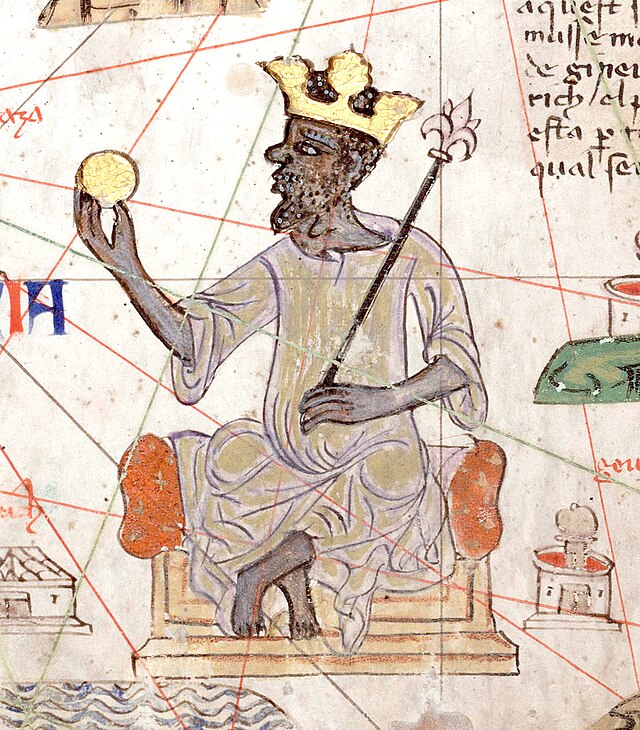
- Mansa Musa
- Mansa Musa was the tenth Mansa, or king, of the Mali Empire.
- He ruled from c. 1312–1337.
- Widely recognised as one of the wealthiest people in human history, he gained much of his wealth through Mali's vast production of salt and gold.
- He was a devout Muslim, and his pilgrimage to Mecca in 1324 is one of the most famous journeys in history, due to the grandeur in which it was carried out.
- On his pilgrimage, he is said to have given away gold and brought as many as 60,000 people along with him.
- During his reign, he made significant cultural contributions, particularly in the areas of architecture and education.
- He commissioned the construction of the famous Djinguereber Mosque in Timbuktu.
-
- He promoted learning and literacy by establishing schools and libraries, with Timbuktu becoming a significant centre of education under his rule.
- His reign marked a period of great prosperity and growth, solidifying Mali's position as a significant power in Africa.
- Ibn Battuta
- Ibn Battuta was a Moroccan scholar and explorer, born in 1304 in Tangier, Morocco.
- He is best known for his extensive travels, which spanned nearly 30 years and covered almost the entire Islamic world and beyond—a distance claimed to be around 75,000 miles.
- His journeys began in 1325, at the age of 21, when he set off to make the Muslim pilgrimage to Mecca, known as the Hajj.
- He travelled to many regions, including North Africa, the Horn of Africa, West Africa, the Middle East, India, Central Asia, Southeast Asia, and China.
- During the course of his travels in West Africa, he visited the Mali Empire and made significant observations about its social and cultural conditions.
- His travelogue, known as the Rihla, provides a crucial source of historical information about the social, cultural, and political environments of a vast region of the world during the 14th century.
Decline and Fall
- The fall of the Mali Empire marked a significant turning point in West Africa's history. The empire began to progressively disintegrate in the late 14th century due to a multitude of internal and external factors. Internal factors, such as succession disputes and the decline of central authority, had a significant impact on the state of affairs. The empire's extensive territorial expansion, which dispersed power among numerous local leaders, heightened tensions.
- The ambitions of these governors, emboldened by their unique access to riches and wealth, often resulted in disputes that threatened the unity of the empire. Conflicts over power and rights upended the system and led to civil wars that weakened the empire.
- Furthermore, the Mansas varied in their effectiveness, with certain rulers imparting less intellect than others who came before them. This difference made it harder for the empire to keep control of its vast lands since it undermined the central authority and caused political unrest.
- The rise of neighbouring countries also posed a serious external threat. The rise of the Songhay Empire to the east was the most significant of these. The Songhay took control of significant trade hubs that had been under Mali's rule in the fifteenth century, demonstrating their growing power.
- Mali's political power and economic stability took a serious hit when Songhay king Sunni Ali took control of cities like Timbuktu in 1468. Changes in the world economy also had an effect on its decline. By establishing maritime channels in the late 15th century, the Portuguese upset trade patterns, avoiding the trans-Saharan routes and severely harming the Mali Empire's economy. During the 17th century, the empire began to split up into smaller states, which resulted in a significant reduction in its size.
Image Sources
- https://upload.wikimedia.org/wikipedia/commons/thumb/8/8f/MALI_empire_map.PNG/1280px-MALI_empire_map.PNG
- https://upload.wikimedia.org/wikipedia/commons/thumb/6/61/The_Mali_Empire.jpg/1024px-The_Mali_Empire.jpg
- https://upload.wikimedia.org/wikipedia/commons/thumb/4/46/Catalan_Atlas_BNF_Sheet_6_Mansa_Musa_%28cropped%29.jpg/640px-Catalan_Atlas_BNF_Sheet_6_Mansa_Musa_%28cropped%29.jpg
Frequently Asked Questions
- What was the Mali Empire?
The Mali Empire was a medieval West African empire that thrived from the 13th to the 16th century. It was known for its wealth, powerful leaders, and cultural achievements.
- Who was Mansa Musa, and what is his significance in Mali's history?
Mansa Musa was one of the most famous rulers of the Mali Empire. He is renowned for his extravagant pilgrimage to Mecca, during which he distributed vast amounts of gold, showcasing the wealth of Mali to the world.
- How did the Mali Empire decline?
The Mali Empire faced internal conflicts, external invasions, and economic decline, contributing to its downfall. The Songhai Empire eventually supplanted Mali as the dominant power in the region.
